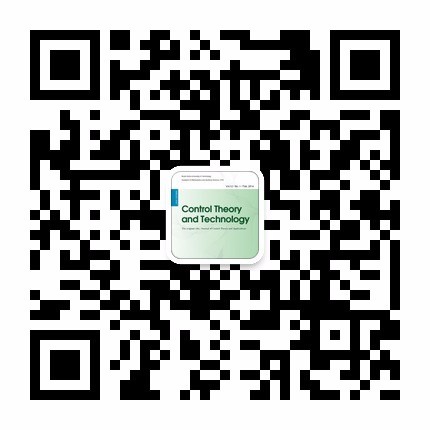| quotation: | | [Copy] |
| | Fu-Xi Chen1,2,Li-Hui Geng1,et al.[en_title][J].Control Theory and Technology,2025,23(2):176~192.[Copy] |
|
| |
|
|
| This Paper:Browse 52 Download 0 |

码上扫一扫! |
| New smoothed-state estimation for correlated process and measurement noises |
| Fu-XiChen1,2,Li-HuiGeng1,2,BrettNinness3,Yong-LiZhang1,2 |
|
|
| (1 School of Automation and Electrical Engineering, Tianjin University of Technology and Education, Tianjin, 300222, China
2 Tianjin Key Laboratory of Information Sensing and Intelligent Control, Tianjin, 300222, China;3 Faculty of Engineering and Built Environment, The University of Newcastle, Callaghan, 2308, NSW, Australia) |
|
| 摘要: |
| This paper addresses the computational problem of fixed-interval smoothing state estimation in linear time-varying Gaussian stochastic systems. A new fixed-interval Kalman smoothing algorithm is proposed, and the corresponding form of the smoother is derived. The method is able to accommodate situations where process and measurement noises are correlated, a limitation often encountered in conventional approaches. The Kalman smoothing problem discussed in this paper can be reformulated as an equivalent constrained optimization problem, where the solution corresponds to a set of linear equations defined by a specific co-efficient matrix. Through multiple permutations, the co-efficient matrix of linear equations is transformed into a block tridiagonal form, and then both sides of the linear system are multiplied by the inverse of the co-efficient matrix. This approach is based on the transformation of linear systems described in the SPIKE algorithm and is particularly well-suited for large-scale sparse block tridiagonal matrix structures. It enables efficient, parallel, and flexible solutions while maintaining a certain degree of block diagonal dominance. Compared to directly solving block tridiagonal co-efficient matrices, this method demonstrates appreciable advantages in terms of numerical stability and computational efficiency. Consequently, the new smoothing algorithm yields a new smoother that features fewer constraints and broader applicability than traditional methods. The estimates, such as smoothed state, covariance, and cross-covariance, are essential for fields, such as system identification, navigation, guidance, and control. Finally, the effectiveness of the proposed smoothing algorithm and smoother is validated through numerical simulations. |
| 关键词: New Kalman smoother · Correlated noises · Fixed interval · Linear time-varying system · SPIKE algorithm |
| DOI:https://doi.org/10.1007/s11768-025-00252-y |
|
| 基金项目: |
|
| New smoothed-state estimation for correlated process and measurement noises |
| Fu-Xi Chen1,2,Li-Hui Geng1,2,Brett Ninness3,Yong-Li Zhang1,2 |
| (1 School of Automation and Electrical Engineering, Tianjin University of Technology and Education, Tianjin, 300222, China
2 Tianjin Key Laboratory of Information Sensing and Intelligent Control, Tianjin, 300222, China;3 Faculty of Engineering and Built Environment, The University of Newcastle, Callaghan, 2308, NSW, Australia) |
| Abstract: |
| This paper addresses the computational problem of fixed-interval smoothing state estimation in linear time-varying Gaussian stochastic systems. A new fixed-interval Kalman smoothing algorithm is proposed, and the corresponding form of the smoother is derived. The method is able to accommodate situations where process and measurement noises are correlated, a limitation often encountered in conventional approaches. The Kalman smoothing problem discussed in this paper can be reformulated as an equivalent constrained optimization problem, where the solution corresponds to a set of linear equations defined by a specific co-efficient matrix. Through multiple permutations, the co-efficient matrix of linear equations is transformed into a block tridiagonal form, and then both sides of the linear system are multiplied by the inverse of the co-efficient matrix. This approach is based on the transformation of linear systems described in the SPIKE algorithm and is particularly well-suited for large-scale sparse block tridiagonal matrix structures. It enables efficient, parallel, and flexible solutions while maintaining a certain degree of block diagonal dominance. Compared to directly solving block tridiagonal co-efficient matrices, this method demonstrates appreciable advantages in terms of numerical stability and computational efficiency. Consequently, the new smoothing algorithm yields a new smoother that features fewer constraints and broader applicability than traditional methods. The estimates, such as smoothed state, covariance, and cross-covariance, are essential for fields, such as system identification, navigation, guidance, and control. Finally, the effectiveness of the proposed smoothing algorithm and smoother is validated through numerical simulations. |
| Key words: New Kalman smoother · Correlated noises · Fixed interval · Linear time-varying system · SPIKE algorithm |
|
|
|
|
|

